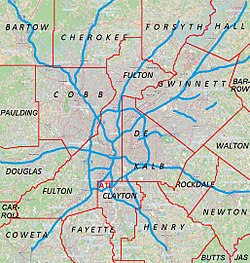Kennesaw
| Kennesaw | |
|---|---|
| City | |
| City of Kennesaw | |

Kennesaw City Hall
|
|
 Location in Cobb County and the state of Georgia |
|
| Location of Kennesaw in Metro Atlanta | |
| Coordinates: 34°1′24″N 84°36′55″W / 34.02333°N 84.61528°WCoordinates: 34°1′24″N 84°36′55″W / 34.02333°N 84.61528°W | |
| Country | United States |
| State | Georgia |
| County | Cobb |
| Incorporated | September 21, 1887 |
| Government | |
| • Mayor | Derek Easterling (R) |
| Area | |
| • Total | 9.5 sq mi (24.7 km2) |
| • Land | 9.4 sq mi (24.4 km2) |
| • Water | 0.1 sq mi (0.3 km2) |
| Elevation | 1,089 ft (332 m) |
| Population (2010) | |
| • Total | 29,783 |
| • Density | 3,155/sq mi (1,218.2/km2) |
| Time zone | EST (UTC-5) |
| • Summer (DST) | EDT (UTC-4) |
| ZIP code | 30144/30152 |
| Area code(s) | 770/678/470 |
| FIPS code | 13-43192 |
| GNIS feature ID | 0316387 |
| Website | www |
Kennesaw is a city in Cobb County, Georgia, United States, located in the greater Atlanta metropolitan area. It had a population of 29,783 according to the 2010 census. Founded in 1887, Kennesaw has a past surrounded with railroad history. During the Civil War, Kennesaw was the staging ground for the Great Locomotive Chase on April 12, 1862.
In 2007, the city was selected by Family Circle magazine as one of the nation's "10 best towns for families". In 2009 Newsmax magazine listed the city among the "Top 25 Most Uniquely American Cities and Towns". The city is perhaps best known nationally for its mandatory gun-possession ordinance.
As the Western and Atlantic Railroad was being built in the late 1830s, shanties arose to house the workers. These were near a big spring. A grade up from the Etowah River became known as "the big grade to the shanties", then "Big Shanty Grade", and finally "Big Shanty".
The name "Kennesaw" is derived from the Cherokee word gah-nee-sah, meaning cemetery or burial ground.
Camp MacDonald, a training camp, was located there from 1861-1863.
During the Civil War, Big Shanty was the site of major fighting in the Battle of Kennesaw Mountain, part of the larger Atlanta Campaign. Kennesaw Mountain National Battlefield Park, located southeast of the city limits, now contains many of these historic areas, though much of the surrounding land has been developed, and some buried artifacts have been taken by people with metal detectors.
...
Wikipedia



